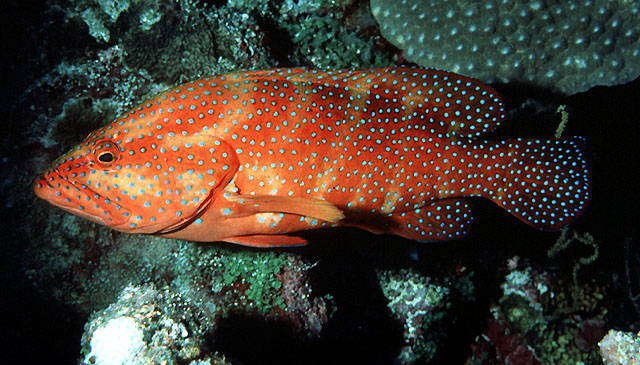
|
Cephalopholis miniata (Forsskål, 1775) Coral hind |
||
| Coral hind, Lapu lapu, Abo-abo, Alatan, Banolog, Bantol, Baraka, Bato-bato, Batol, Coral cod, Iner, Inid, Jahong, Kakab, Kaltang, Kigting, Kubing, Kugtong, Kugtung, Kulapo, Kurapo, Kurapu, Labungan, Lapu-lapu, Lapu-lapung lupot, Lapu-lapung señora, Liglig, Lilug, Lubo, Mamonbong, Mantis, Maskad, Matkad, Ogaw, Pagupo, Pakes, Pugapo, Pugapo salapok, Pugayo, Salingukod, Sibog, Sigapo, Tabadlo, Tangk-an, Ting-ad, Tingag | ||

|
|
photo by
Randall, J.E. |
| Family: | Epinephelidae (Groupers) | |||
| Max. size: | 50 cm TL (male/unsexed) | |||
| Environment: | reef-associated; marine; depth range 2 - 150 m, non-migratory | |||
| Distribution: | Indo-Pacific: Red Sea to Durban, South Africa and eastward to the Line Islands; including most islands in the Indian and west-central Pacific oceans. Absent from Persian Gulf and Gulf of Oman. Misidentified as Cephalopholis cyanostigma from Reunion (Ref. 6453). | |||
| Diagnosis: | Dorsal spines (total): 9-9; Dorsal soft rays (total): 14-15; Anal spines: 3-3; Anal soft rays: 8-9. Color orange-red to reddish brown, usually dark posteriorly with numerous bright blue spots which are smaller than the pupil and often faintly dark-edged on head, body and median fins; distal margin of caudal fin and soft portions of dorsal and anal fins usually with a narrow blue margin and blackish submarginal line; orange-yellow pectoral fins, on some only distally; orange-red pelvic fins; it is capable of a disruptive color pattern of irregular oblique olivaceous bars; juveniles may be yellow with scattered faint blue spots. D IX, 14-16; A III, 8-9 (rarely 8); pectoral 17-18 (often 18); scales on lateral line 47-55; scales on longitudinal series 94-114; snout anterior to nostrils no scales; partially scaled maxilla; abdomen with cycloid scales; gill rakers 7-9 + 13-15; depth of body 2.65-3.05 in SL; length of head 2.4-2.65 in SL; the maxilla extends to or posterior to rear of the orbit; smooth ventral margin of preopercle; 5th - 8th dorsal spines longest , 3.0-3.6 in head; pectoral fins 1.45-1.75 in head; pelvic fins do not reach the anus, 1.9-2.3 in head (Ref. 4787). | |||
| Biology: | Inhabit clear waters of coral reefs; more often found in exposed rather than protected reef areas (Ref. 5213). Feed on fishes (80%, mainly Pseudanthias squamipinnis) and crustaceans. Form haremic groups comprising of a dominant male and 2 to 12 females. These groups occupy territories of up to 475 sq m subdivided into secondary territories and defended by a single female (Ref. 6480). Generally common (Ref. 9710). | |||
| IUCN Red List Status: | Least Concern (LC); Date assessed: 12 November 2017 Ref. (130435) | |||
| Threat to humans: | harmless | |||
| Country info: | Recorded in Tañon Strait (Ref. 107276). Known from Puerto Princesa, Palawan (Ref. 58652) and Lanuza Bay (Ref. 104756), Bongo Island and Paril-Sangay Protected Seascape, Moro Gulf (Ref. 106380). Museum: SMF 17577. Zamboanga, USNM 57843. Burias Is., USNM 170749. Batan Is., Sabtang Is., USNM 170748. Basilan Is., ZUMT 39401. Negros, Dumaguete, CAS 51690. Batangas, BPBM 23463. Babuyan Is., Calayan Is., SU 20681. Also Ref. 4787, 5222, 48613, 59110, 121724. | |||